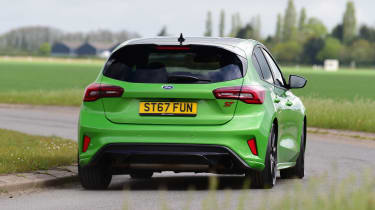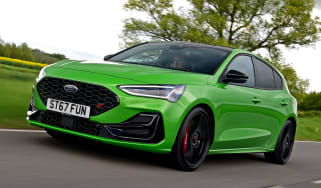Ford Focus ST review - Engines, drive & performance
"It might have lots of go-faster gadgets but the Focus ST's main attribute is a great chassis"
The Focus ST has certainly taken a step on in performance because, while the ST has long been the more sensible Ford hot hatch sitting below the barking RS, its power has been upped to match rivals like the Hyundai i30 N Performance in the absence of a new RS.
Sitting on an entirely new chassis, Ford has sharpened up the driving experience too, increasing the speed of the steering by 15% compared with the standard Focus models, which is hardly vague in the first place. It's chucked just about every other hot hatch toy at the ST too, including clever front suspension geometry, stiffer suspension settings, a 10mm lower ride height and an electronically controlled limited-slip differential that improves agility and traction.
The ride is firm but there are huge reserves of grip and the ability to dive into corners with a mere flick of the steering wheel. The steering can tug at your fingertips slightly as you accelerate but, according to Ford, a degree of 'torque steer' has been left in to give the car character. The sheer speed of the steering's response also requires a bit of getting used to - it makes the ST incredibly agile, but this can also give the fast Focus a slightly nervous character across a typically narrow, bumpy back road with a heavily cambered surface. Of the hot hatchbacks on offer, the Focus ST is one of the most hardcore options, making the Volkswagen Golf GTI a better bet if you want a more relaxing car day-to-day.
More reviews
You can adjust how the ST responds by cycling through four driving modes directly on the steering wheel, and Track is the most hardcore, bringing the ST to life by stiffening its suspension, boosting engine response and liberating pops and bangs from the exhaust. Sport feels suitable for smoother roads, but noticeably bouncier than the standard setting, which is still firm, but soaks up most bumps without sending a shudder through the bodyshell.
Briefly sitting alongside the standard ST was the Focus ST Edition, a more hardcore version with tweaks to improve handling but no additional power. It features manually adjustable suspension that’s 10mm lower than the normal ST, lightweight wheels and firmer springs. Despite these changes, it rides really well over all but the nastiest potholes. The ST Edition makes you want to go faster and faster but there are rivals that are able to settle down to a cruise more easily.
2024 has seen the return of the ST Edition that was previously available in 2021, before the facelifted car arrived. Like before it gets uprated adjustable KW coilover suspension, which is 10mm lower than standard and can be lowered a further 20mm, with even more involved adjustments possible – it comes with a document detailing the recommended settings if you wish to tweak them further. This model also comes with uprated Brembo front brakes and lighter 19-inch alloys, and the whole car is distinguishable by its Azura Blue paint colour and gloss black exterior trim. It’s only available with the six-speed manual for the utmost in driver involvement.
A Track Pack including some of the aforementioned upgrades is also available, costing just £3,000 more, so it’s worth it if you want to take your Focus ST to the next level in terms of sporting prowess. The result is a car with handling that’s near the top of the class and brakes with impressive bite and feel through the pedal. Like the Hyundai i30N the ST Track Pack feels like the ultimate expression of an old-school hot hatchback. While the Honda Civic Type R is even faster and more precise, it’s now almost in another class that competes with models costing around £10,000 more like the Volkswagen Golf R.
Ford Focus ST petrol engine
Essentially a less powerful version of the Ford Mustang’s EcoBoost engine, the turbocharged 2.3-litre petrol engine in the ST serves up 276bhp and 420Nm of torque - a big jump from the previous generation. While still some way off the 316bhp Honda Civic Type R, the ST is a few horsepower ahead of the i30N Performance, and way ahead of the 242bhp Golf GTI.
A 0-62mph time of 5.7 seconds is certainly impressive for a front-wheel drive car and the ST has plenty of clever features. Most intriguing for rally fans is its 'anti-lag' turbo technology, recently seen in the Ford GT supercar and F-150 Raptor pick-up. By keeping the throttle open in Sport and Track driving modes, even when the driver lifts off the accelerator, the turbocharger keeps spinning so it can provide full boost when you come back on the throttle. The larger-than-class-average size of the 2.3-litre engine certainly helps with bursts of acceleration, and it's when driving between bends or overtaking that the ST feels most impressive.
In the six-speed manual you can also 'flat-shift' up through the gears without coming off the accelerator, while downshift rev-matching blips the engine as you change down to ensure each gear engages smoothly. Despite all this tech, and the fact it has class-leading torque, the engine isn't the highlight of the car next to the sparkling chassis. That's probably because from anything above 1,800rpm the engine is undeniably effective but simply piles on speed with a flat blare from its twin exhaust pipes.
A new seven-speed automatic gearbox is also available, with a 0-62mph time of six seconds flat. Unlike the snappy automatics in models like the Volkswagen Golf GTI and Audi S3, we wouldn't recommend it. While it shifts smoothly enough when driving gently, the auto feels lethargic when you want quicker changes, making it feel out of sync with the hyperactive personality of the ST.
Diesel engine
When it was available, Ford's 2.0-litre EcoBlue diesel with 187bhp was the most powerful ever offered in a diesel Focus and 5bhp more than the Volkswagen Golf GTD and Skoda Octavia vRS offer. The BMW 120d matches the Focus ST' power exactly, and with the move to front- or four-wheel drive, it's more of a rival than ever. However, even in its most performance-orientated M Sport guise, the BMW is less hardcore and has softer suspension than the Ford.
Acceleration from 0-62mph takes 7.6 seconds, while the diesel ST has a top speed of 137mph. With 360Nm of its total 400Nm of torque on tap from just 1,500rpm, it should also be ideally suited to overtaking.













